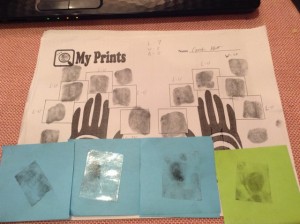Â

Fingerprints are fascinating. Who knew that the ridges of skin on your fingers could be so unique? Yet another accidental and amazing mystery of the natural world. Our first experience in class was with ink. The ink pad is messy, and so were our pages where we laid our ten prints. The backs of our pages were equally messy with “practice†prints. It is difficult to get an entire solid impression on the page. No wonder it takes a full education to become an expert! We learned about following the ridges, and the three different patterns; loop, whorl, arch. Each pattern has to do with entry/exit points of each ridge and their directional centers, or deltas. We also learned the 60-35-5 distribution between the three classes. Each class has various sub-classes to distinguish the print even more! Fingerprints are matched by finding “loci†or points of interest that make each print unique. 11 or 13 loci matches is the current regulation as a full match
I think that it is very clever to take advantage of  this unique characteristic for the purpose of identification and distinction. During class, we picked up glass beakers with our bare hands and then attempted to copy the prints left using fingerprinting powder and lifting tape. It was fairly easy to leave fingerprints on this smooth glass surface. The oils/skin on my fingers left over was uncovered with a few sweeps of the extra-fine powder and brush. A few of the fingerprints were harder to recover, and some were smudged. After carefully placing the tape, the dust pattern was peeled and layed down onto the solid background of a sticky note. The results were varied, with some reading like they were examples and others hard to decipher because of  incomplete prints or other dust smudge. Im glad that I pulled more than one, so that I could get at least one or two.
      Fingerprints are a very important part of forensic science. Although extremely useful, they are not always usable. Rough or textured surfaces, such as a gun or a piece of wood, do not always retain an easy fingerprint to retract. Some crime scenes may have no fingerprints at all, solved by the added protective measure of wearing gloves. Multiple fingerprints that overlap also cause reading problems. Dust is not the only way fingerprints are read. there are chemical and photo-luminescent ways that work as well for different situations. Still, the fingerprints may not always be clear. Direct fingerprint scanning and comparison in a database is a very solid indicator, and I believe that It will still be usefull years ahead. In terms of fingerprints at a crime scene, using multiple sources that correspond and collectively build a strong case is always the most error-free option.Â
